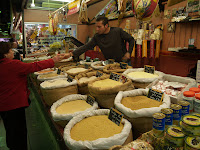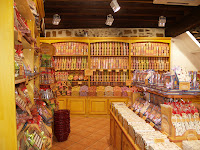


We’ve had several requests for a more detailed post about the food and wines here. Just to help break it up a bit I’ll cover food in this post and wine and beer in the next one. The photos in the post were taken inside a market in Nimes and is typical of other markets in the area.
Surprisingly the food has been something of a mixed bag. Since we’re not on vacation we’re not eating at restaurants very often so I can’t say I’ve had any amazing French meals and I think that I expected it to be somewhat different. There is the internationalized ‘French’ food that we tend to get at home as well as all over France- in that sense it is also the nationalized French food. We did have one meal, sort of in that vein that was pretty good, I had Coq au Vin and Allison had a seafood dish with capers and a citrus sauce on two different fish all of which was well done. The tragedy of the internationalized French cuisine is that it drowns out more of the local foods. The cassoulet, which I thought would be all over the place I haven’t seen at all in Montpellier- though we saw it at Carcassonne. Most of the restaurants have menus at varying prices from twelve to thirty Euros, which generally offer an entrée (appetizer) and a main dish or a main dish and a dessert. Most restaurants, brasseries, even cafes offer this type of pricing.
There is good diversity among the non-French restaurants. There is heavy middle- eastern influence as there are large populations from North Africa and the fertile crescent as well as a few Turks. Due to this influence there are very good kebabs and pastries that are more Middle Eastern rather than French. Italian foods, especially pizzas are quite common, very affordable and while they of course vary we have had several pizzas that were really good. There are some Asian restaurants- a Vietnamese place that looks interesting, several Chinese places, and more than a few sushi restaurants. We went for sushi last week with friends after Allison and Rachel had finished their final exam in French. The flavors were certainly those of sushi and while it was far from life changing, it was nice to have.
There is a fair amount pick up foods- sandwiches, the tielles that we had in Sete (fish and mussel calzone type things) kebabs, quiches, and pizza. They are all generally fresh, cheap and quite good. Those are more often made at bakeries and are purchased to-go. The bread is also excellent. There is the ubiquitous baguette, which can be great or terrible but there is also a great deal of variety in styles outside of that- more ball shaped loaves, breads with different grains mixed in, flaxseed, called linseed here, rye, and others. Bread in general is cheap- a baguette no matter the quality range from 50-80 cents and some can be found for as low as 25 cents, which seems crazy. The more specialty breads are either sold by the piece or more commonly by the kilo. Those all range depending on the ingredients but for a whole wheat “specialty loaf” we don’t spend more that 2 Euros 50. We’ve found variety and quality to be quite high and on any given day we have we have five bakeries to choose from, all within a five- minute walk from our building. One of the nearest bakeries has a rotisserie wagon conveniently parked next to it. We’ve bought rotisserie chickens for both Thanksgiving and Christmas but she is there every day and does a pretty brisk trade. The meat is great and with our limited meat roasting abilities it is very nice to have!
So while the restaurant report is certainly mixed I have to say that there is absolutely no question why France is so famous for good food. The fresh ingredients are amazing. The small market that we have just down the street on Saturday mornings has a tremendous variety of the freshest fruits, vegetables, meats, breads, and cheese. They also have a huge variety of olives, oils, salamis, dried hams (prosciutto), preserved fruits, spices, honeys, and nearly every other ingredient you can think of. It is all incredibly inexpensive and usually very high quality. Some things are imported but by and large everything is local or at least regional.
The only thing that costs much money (by American standards) is fresh meat. The meat tends to be quite fresh, and high quality but it is quite a bit more expensive which I think figures in to both why there are so many parts of animals that are used here that aren’t popular in the US (blood, organ meats, tongue etc.) and also why portions of meat that people eat tend to be smaller. Sausages like salami are pretty good also with many different sorts of flavors- crusted with black pepper, herbs d’provence, truffles, olives and the list goes on. There are also different sorts of meat- guinea fowl, and other smaller birds- I’ve seen quail, and pheasant also once in the cafeteria at school they served ostrich. There’s plenty of rabbit available too.
The cheeses are very good. The generic camembert or brie style cheeses are certainly all over but there are very good fresh sheep and goat cheeses that are fairly typical of the milk that they come from but not really funky from long ageing. There are a few harder cheeses Comte, some goudas, some harder Basque cheeses which are more like the Spanish manchego, Roquefort is widely available as are a few other bleus, St. Marcelain (the cheese that normally comes in a small ceramic ramekin) and a number of other soft cheeses like that are available in packs of five all wrapped up like lifesavers. I’ve liked the hard cheese from Laguiole- where the corkscrews and knives come from, which has a granular or crystalline texture when aged, similar to aged gouda or parmesan. Cheeses are generally quite affordable and where shops in the States have storebrands for a few cheeses: shredded parmesan, cheddar, jack cheeses and maybe pepper-jack, the stores in France are much less fortunate they have maybe 20 or 30 different cheeses of varying appellations just to cover the house brand (“Safeway Select” sort of thing) along with the higher end examples from many places. Much like the wines the cheeses are celebrated for their geographic diversity so even though the cheeses come from similar if not exactly the same tradition it is regarded as very different which allows the region to stand out with a unique product. The French do love milk products, there are aisles of cheeses, yogurts, desserts, ice creams, crème fraiche, kefirs, and any other milk product you can think of. The milk on the other hand is almost all pasteurized for long- term storage and sold off the dry goods shelf in tetra paks and plastic bottles- sort of strange for a place that celebrates cheeses made from unpasteurized milk.



With the different vegetables, like leeks, great carrots, different potatoes and the like we’ve made many more soups than we ever had made before. It has worked out well to not know what to do with something and just throwing it in some soup to see what it is like. We’ve cooked a lot more with leek- something that never really occurred to me to buy at home. The fresh salad greens are very good as well.
Overall we have about the same diversity at home but the quality seems very high and priced very well. The discount store, Lidl, up the hill has pretty good produce and while the thought of buying much produce at Grocery Outlet or Trader Joe’s our two most popular discount retailers sounds a little sketchy, here the number of choices are fewer but the quality is pretty high.
One noticeable difference is the onion. French onions are more pungent- also are a packaged in bulk, often still with a good coat of dirt. They are also smaller, in general, than the onions at home. I suppose that might suggest something about the criteria by which onions are grown and marketed in the US. I feel that is true of many of the vegetables and fruits here. Another good example is apples, they tend to be smaller, have a bit more scab or sunburn but they taste great… the opposite of an all-American red delicious which is mostly shine and flawless skin and then mono-dimensional flavor-wise with mealy flesh. Of course the more interesting varieties: gala, braeburn, cameo are great at home too but still larger and less rustic looking.
We do most of our shopping at either one of the big Hypermarkets like Casino (unfortunately there aren’t any slot machines) or Carrefour for wine, some vegetables, and more specialized groceries that Lidl doesn’t have. We buy the more usual stuff, milk, some cheeses, meat and basic spaghetti sauce, beans etc at Lidl the funky discount joint that is just up the street from us. We get bread at whichever of the bakeries is on our way.
The different sorts of shops are interesting. Lidl and other hard discounters are pretty popular. They have larger lots of stuff but they have things produced for them they’re not just buying end runs of things so you can often get the same product there every time. There are small neighborhood markets- epiceries which can have high-end specialty stock- for example the high end place near us has expensive craft chocolate, a small but high end wine selection, and then they do a brisk business in foie gras this time of year. Another place just down the street is called an epicerie also but it is much more of a convenience store. Slightly larger are the super markets which tend to be mostly food, larger than epiceries and have a pretty wide selection of stuff. Then the Hypermarkets are more like a Fred Meyer but with a much better grocery department and they are normally a good deal larger. These places tend to have big deli departments well stocked with cheeses and meats. Most have good wine departments as well as large produce departments. There are also electronics, house-wares, clothes and appliances, so pretty much anything you might need is there.
There are also always specialists. Fruit and vegetable shops, cheeses shops, butchers, wine shops and the like. We buy from these types occasionally mostly for one or two things out of convenience or if we’re looking for something particular that only a specialty shop might have. As romantic as it sounds to go to the butcher, the fruit stand, the general store for groceries it just isn’t in our budget as this type of shopping is generally more expensive.




















































